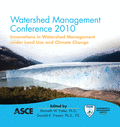In Situ Sensors for Measuring Pollutant Loads in Urban Streams and Evaluating Stormwater BMP Performance
Publication: Watershed Management 2010: Innovations in Watershed Management under Land Use and Climate Change
Abstract
Population growth and the resulting urban sprawl are increasing the impervious surface area throughout the state of Minnesota. From 1990 to 2000, impervious surface area increased in Minnesota by 44%. More importantly, this included increases of more than 100% in 20 of the 81 major watersheds in the state (Bauer et al., 2007). These increases in impervious surface area are worrisome as they prevent infiltration which is an effective, natural method for treating stormwater and thus reducing its impact upon surface waters. Because most non-point source (NPS) pollution results from a lack of infiltration, rain events in areas with a high percentage of impervious surfaces cause water to accumulate a multitude of pollutants including harmful anthropogenic organic compounds, nutrients, pathogens, and particulates before washing off into nearby waterways. The concern stemming from NPS pollution has increased dramatically with increasing urbanization and as a result, multiple best management practices (BMPs) have been identified and established to minimize the impact of storm events on surface water quality (MPCA, 2005). Current practices to stem the effects of stormwater runoff include various forms of stormwater ponds, wetlands, channels and engineered systems involving filtration and settling techniques. Previous studies performed for the US EPA show high pollutant removal for phosphorus and total suspended solids in both pond systems and wetlands, with the ponds performing better (Winer, 2000). Neither BMP was very effective at removing metals and nitrogen though (Winer, 2000). Overall stormwater ponds and wetlands tend to be the most effective BMPs when the removal of all major pollutants is assessed. Unfortunately these systems lose effectiveness with age and thus may become ineffective if they are not monitored and maintained correctly (Winer, 2000). In this study, we have used a wireless sensor network to evaluate BMPs and water quality in two urban creeks. Shingle Creek flows through residential, commercial, and industrial areas, has a highly impervious watershed, and discharges into the Mississippi River in Minneapolis, MN. Minnehaha Creek is fed from Lake Minnetonka and winds through the western suburbs of Minneapolis, MN. The landscape surround this creek ranges from agricultural and recreational to highly urbanized as it approaches its discharge at the Mississippi River. The flow of this creek is regulated by a dam in Lake Minnetonka, and when this dam is closed the flow is primarily a result of stormwater runoff, and thus, so is the pollutant loading.
Get full access to this article
View all available purchase options and get full access to this chapter.
Information & Authors
Information
Published In
Copyright
© 2010 American Society of Civil Engineers.
History
Published online: Apr 26, 2012
ASCE Technical Topics:
- Best Management Practices (BMPs)
- Design (by type)
- Engineering fundamentals
- Environmental engineering
- Equipment and machinery
- Infrastructure
- Load factors
- Pollution
- Probe instruments
- River engineering
- Rivers and streams
- Stormwater management
- Structural design
- Urban and regional development
- Water and water resources
- Water pollution
- Water treatment
Authors
Metrics & Citations
Metrics
Citations
Download citation
If you have the appropriate software installed, you can download article citation data to the citation manager of your choice. Simply select your manager software from the list below and click Download.
